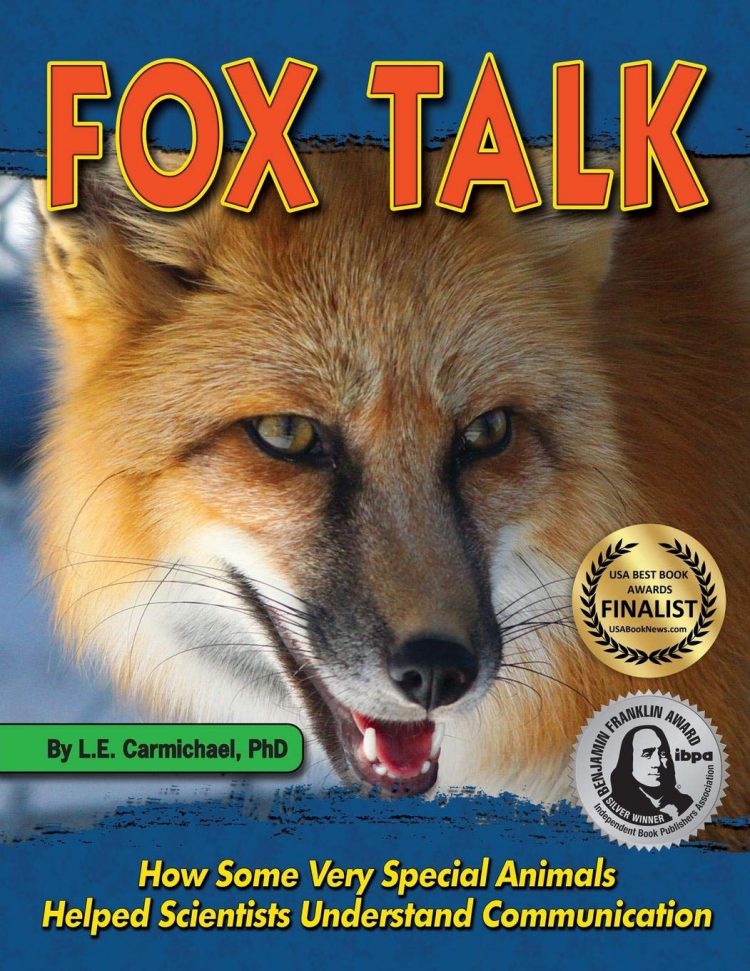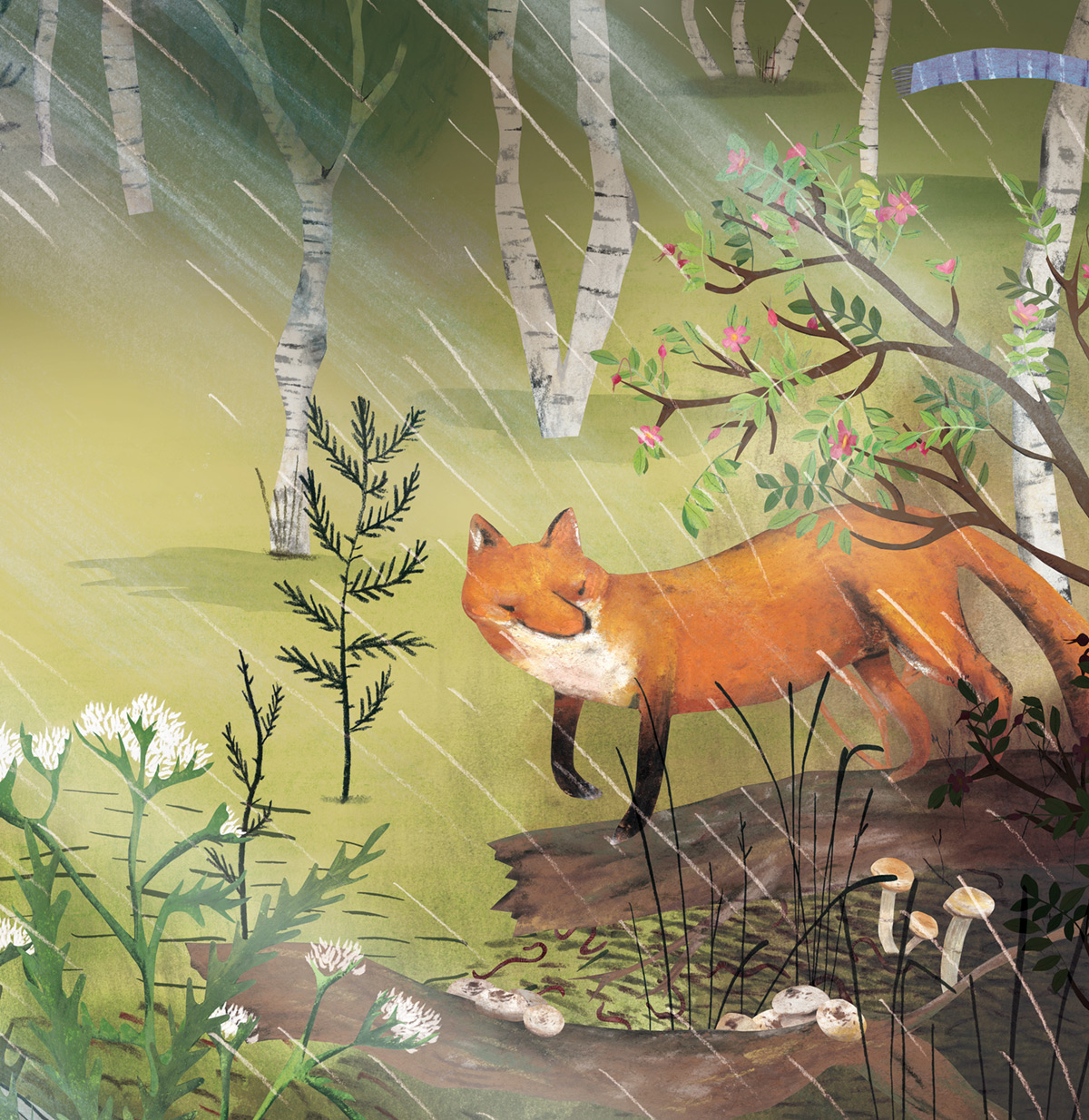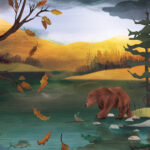Explore Books for Middle Grades
Dig into high-concept topics with Lindsey’s middle grade science books. These titles take confident readers on journeys of discovery and delight.
Polar: Wildlife at the Ends of the Earth
The Arctic and Antarctica, at opposite ends of the Earth, have much in common: bitter cold, ferocious winds and darkness lasting six months. Despite these harsh conditions, many animals have adapted to stay alive in the polar regions. This evocative and beautifully illustrated book from the award-winning team of author L. E. Carmichael and illustrator Byron Eggenschwiler explores how animals at opposite ends of the Earth survive using similar adaptations. There’s the arctic fox who is protected from the ice by the fur on the soles of her feet, the emperor penguins huddling in groups around their chicks to keep everyone warm, and the narwhal using echolocation to find a crack in the surface ice to breathe. It’s a fascinating journey through a year in the polar regions, where animals don’t just survive – they thrive!
Details
Polar: Wildlife at the Ends of the Earth
From the author of the critically acclaimed The Boreal Forest, a stunning exploration of the animals that have adapted to survive in Earth’s harsh polar regions.
The Arctic and Antarctica, at opposite ends of the Earth, have much in common: bitter cold, ferocious winds and darkness lasting six months. Despite these harsh conditions, many animals have adapted to stay alive in the polar regions. This evocative and beautifully illustrated book from the award-winning team of author L. E. Carmichael and illustrator Byron Eggenschwiler explores how animals at opposite ends of the Earth survive using similar adaptations. There’s the arctic fox who is protected from the ice by the fur on the soles of her feet, the emperor penguins huddling in groups around their chicks to keep everyone warm, and the narwhal using echolocation to find a crack in the surface ice to breathe. It’s a fascinating journey through a year in the polar regions, where animals don’t just survive – they thrive!
Each spread in the book is devoted to a month and includes a themed introduction and two stories on opposites pages, one about an animal in the Arctic and one about an animal in Antarctica. Extra spreads cover topics such as seasons, winter weather and types of ice. The book concludes with a timely description of the disruptions that climate change is causing to the polar regions, and how this will have global consequences. A glossary, further reading, author’s sources, an index and ideas for what children can do to help are included. There are strong life science curriculum applications here in animal habitats and animal adaptation, migration, hibernation and cooperation.
Click here to download the free Teachers’ Guide from Kids Can Press.
Click here for Polar Presents: The Official Activity Guide and Other Free Resources Around the Web
Best Of Lists:
IndigoKids Christmas Gift Guide – 2023
Chicago Public Library – Best Informational Books for Older Readers 2023
Starred Selection in CCBC’s Best Books for Children and Teens (Fall 2023)
Reviews
Where to Buy
The Boreal Forest: A Year in the World’s Largest Land Biome
The vast boreal forest spans a dozen countries in the northern regions like "a scarf around the neck of the world," making it the planet's largest land biome. Besides providing homes for a diversity of species, this spectacular forest is also vitally important to the planet: its trees clean our air, its wetlands clean our water and its existence plays an important role in slowing global climate change. In this beautifully written book, award-winning author L. E. Carmichael explores this special wilderness on a tour of the forest throughout the four seasons, from one country to another. Evocative watercolour and collage artwork by award-winning illustrator Josée Bisaillon provides a rare glimpse of one of the world's most magnificent places.
Details
The Boreal Forest: A Year in the World’s Largest Land Biome
The vast boreal forest spans a dozen countries in the northern regions like “a scarf around the neck of the world,” making it the planet’s largest land biome. Besides providing homes for a diversity of species, this spectacular forest is also vitally important to the planet: its trees clean our air, its wetlands clean our water and its existence plays an important role in slowing global climate change. In this beautifully written book, award-winning author L. E. Carmichael explores this special wilderness on a tour of the forest throughout the four seasons, from one country to another. Evocative watercolour and collage artwork by award-winning illustrator Josée Bisaillon provides a rare glimpse of one of the world’s most magnificent places.
With excellent STEM applications in earth science and life science, this enjoyable book aims to foster environmental awareness of and appreciation for this crucial forest and its interconnections with the entire planet. In a unique approach, the text features a lyrical fictional narrative describing the wildlife in a specific part of the forest, paired with informational sidebars to provide further understanding and context. Also included are a world map of the forest, infographics on the water cycle and the carbon cycle, a glossary, resources for further reading, author’s sources and an index. This book has been reviewed by experts and was written in consultation with Indigenous peoples who live in the boreal forest region.
Click here to download the free Teaching Guide for The Boreal Forest
Click here for The Great Big Boreal Forest Resource List, including a free downloadable activity guide.
Best Of Lists:
Bank Street College of Education – Best Books of the Year 2021, 9-12-years-old
Chicago Public Library – Best Informational Books for Older Readers of 2020
Ontario Library Association – Best Bets of 2020
American Library Association – Top 10 Sustainability-Themed Children’s Books 2021
Reviews
Where to Buy
Forensics in the Real World
First, learn what forensics is and how it came to be. Then, peek inside the daily lives of the real crime scene investigators, forensic specialists, and research scientists that help solve crimes every day. Includes insight into real cases and plenty of info on what it takes to do these important jobs.
Details

Forensics in the Real World
Forensic scientists study crime scenes, examine evidence, and invent new ways to solve crimes. Forensics in the Real World examines the history of this field, what forensic scientists do today, and what’s next for this branch of science. Easy-to-read text, vivid images, and helpful back matter give readers a clear look at this subject. Features include a table of contents, infographics, a glossary, additional resources, and an index. Aligned to Common Core Standards and correlated to state standards.
Reviews
Innovations in Entertainment
Imagine a time when video games did not exist! You might not realize that there was once a world without your favorite entertainment forms. From games and music to electronic television and downloadable movies, this title looks at major innovations in entertainment over the years, and the ingenious inventors, scientists, and engineers who made them. With a little inventive thinking, what might you create to help us learn new things, enjoy our free time, and connect with each other?
Details

Innovations in Entertainment
Imagine a time when video games did not exist! You might not realize that there was once a world without your favorite entertainment forms. From games and music to electronic television and downloadable movies, this title looks at major innovations in entertainment over the years, and the ingenious inventors, scientists, and engineers who made them. With a little inventive thinking, what might you create to help us learn new things, enjoy our free time, and connect with each other?
Reviews
Innovations in Health
You might be shocked to discover how some illnesses and diseases were treated years before medical innovations were made. This book will make you feel lucky that you were born after many safe and successful ways were developed to treat illnesses and save lives. Learn about important innovations made in health care that we now take for granted, and the amazing scientists, inventors, and engineers who developed them. With a little inventive thinking, how could you come up with a way to keep you and your family healthy?
Details

Innovations in Health
You might be shocked to discover how some illnesses and diseases were treated years before medical innovations were made. This book will make you feel lucky that you were born after many safe and successful ways were developed to treat illnesses and save lives. Learn about important innovations made in health care that we now take for granted, and the amazing scientists, inventors, and engineers who developed them. With a little inventive thinking, how could you come up with a way to keep you and your family healthy?
Reviews
The Science Behind Gymnastics
Behind every jump, spin, and flip of Olympic gymnastics, science is at work. Centrifugal force is at work in a midair spin, and centre of gravity is involved in balance beam routines. Newton’s Third Law of Motion springs into action as a gymnast flies into the air in the vaulting event. Find out how science is involved in all your favourite gymnastics events and how gymnasts take science into account as they chase the gold medal.
Details

The Science Behind Gymnastics
Behind every jump, spin, and flip of Olympic gymnastics, science is at work. Centrifugal force is at work in a midair spin, and centre of gravity is involved in balance beam routines. Newton’s Third Law of Motion springs into action as a gymnast flies into the air in the vaulting event. Find out how science is involved in all your favourite gymnastics events and how gymnasts take science into account as they chase the gold medal.
Reviews
Where to Buy
How Can We Reduce Agricultural Pollution?
Everyone needs to eat, yet farming is a major cause of pollution around the world. But did you know that certain types of farming create less pollution than others? Or that some types of waste can be made into energy? Investigate what we can do to reduce agricultural pollution.
Details

How Can We Reduce Agricultural Pollution?
Everyone needs to eat, yet farming is a major cause of pollution around the world. But did you know that certain types of farming create less pollution than others? Or that some types of waste can be made into energy? Investigate what we can do to reduce agricultural pollution.
Reviews
Discover Forensic Science
Forensic scientists study evidence to figure out who committed a crime. But how do they determine the cause of death? And how do they use trained dogs and devices to track scents? Learn about the latest tools and techniques in use by forensic scientists, and discover how their work helps bring criminals to justice.
Details

Discover Forensic Science
Forensic scientists study evidence to figure out who committed a crime. But how do they determine the cause of death? And how do they use trained dogs and devices to track scents? Learn about the latest tools and techniques in use by forensic scientists, and discover how their work helps bring criminals to justice.
Reviews
Fox Talk: How Some Very Special Animals Helped Scientists Understand Communication
When you talk to a dog, does the dog talk back? Many people think so. But for a long time, scientists didn't know how our furry friends learned to communicate with people. Packed with eye-popping photos and first-hand research, Fox Talk reveals the story of these amazing animals... and everything they've taught us about wolves, dogs, and communication.
Details

Fox Talk: How Some Very Special Animals Helped Scientists Understand Communication
When you talk to a dog, does the dog talk back?
Many people think so. But for a long time, scientists didn’t know how our furry friends learned to communicate with people.
Luckily, Russian scientist Dmitri Belyaev had a plan. If he could tame wild red foxes, he could learn how dogs first came from wolves. By studying the way these foxes changed during domestication, the mystery of communication would be solved at a last.
More than 50 years after the experiment began, Belyaev’s foxes have become so tame, you can have one as a pet! Packed with eye-popping photos and first-hand research, Fox Talk reveals the story of these amazing animals… and everything they’ve taught us about wolves, dogs, and communication.
Note: Fox Talk has gone out of print, but used copies may still be available online.
Reviews
The Scientific Method in the Real World
Examines the history of the scientific method and describes each of its components, which include making observations, asking questions, creating hypotheses, running experiments, and looking for patterns in the results.
Details

The Scientific Method in the Real World
Explore the scientific method! This book uses real-world examples to bring the concept of the scientific method to life in an approachable way. Clearly-written text draws in readers with concrete examples involving familiar, everyday things. The book covers the history of and key figures in the understanding of the scientific method, including Aristotle, Galileo, Isaac Newton, and Charles Darwin. Major concepts covered include the four steps of the scientific method (observe, explain, experiment, share), forming a hypothesis, Ockham’s razor, theories, variables, controls, and bias. Full-color photos, a glossary, an index, sidebars, primary source documents, and other creative content enhance the book. It also includes prompts and activities that directly engage students in developing the reading, writing, and critical thinking skills promoted by the Common Core standards. This well-researched title has a credentialed content consultant and aligns with Common Core and state standards.



























